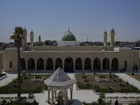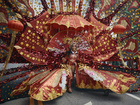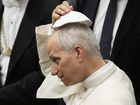Pope Leo XIV said in his first interview as history's first American pope that he has no intention of getting involved in U.S. politics but will raise his voice on issues of concern to the Catholic Church, including on immigration.
 Full Story
Full Story
Nine hours of frantic negotiation with the Israeli military. A last-minute scramble to find trucks in a devastated Gaza Strip, where fuel is in short supply. Six hours of frantic packing, carefully stacking cardboard boxes on open flatbed trucks.
 Full Story
Full Story
Each year during Hispanic Heritage Month, huge celebrations can be expected across the U.S. to showcase the diversity and culture of Hispanic people.
This year, the Trump administration's immigration crackdowns, a federally led English-only initiative and an anti-diversity, equity and inclusion push have changed the national climate in which these celebrations occur. Organizers across the country, from Massachusetts and North Carolina to California and Washington state, have postponed or canceled heritage month festivals altogether.
 Full Story
Full Story
Alexandre Paulikevitch put on his white dress and wig and danced his way to center stage, knowing that the extremist groups who had threatened him before his controversial recital might be waiting for him outside the theater.
The Lebanese dancer's sold-out performance to a cheering crowd at a popular Beirut venue had angered fundamentalist movements ranging from the right-wing Christian Soldiers of God to Sunni Islamists.
 Full Story
Full Story
A Belgian festival said Thursday it stood by its decision to axe a leading German orchestra's performance over concerns about its Israeli conductor -- despite furious protests from Israel and Berlin.
 Full Story
Full Story
Pope Leo XIV fed fish in the fishpond, pet horses and visited organic vineyards Friday as he inaugurated the Vatican's ambitious project to turn Pope Francis' preaching about caring for the environment into practice.
Leo formally opened Borgo Laudato Si, a 55-acre utopian experiment in sustainable farming, vocational training and environmental education located on the grounds of the papal summer retreat in Castel Gandolfo. The Vatican hopes the center, open to student groups, CEOs and others, will be a model of ecological stewardship, education and spirituality for the Catholic Church and beyond.
 Full Story
Full Story
Pope Leo XIV and his top diplomats thave old Israel's president that a two-state solution was the "only way out of the war," as the Vatican called for a permanent ceasefire in Gaza, the release of all hostages and entry of humanitarian aid to famine-stricken Palestinians there.
The Vatican issued Thursday an unusually detailed statement following Leo's meeting with Israeli President Isaac Herzog, who also met with the Vatican secretary of state Cardinal Pietro Parolin and foreign minister, Archbishop Paul Gallagher. Herzog, for his part, said he had asked Leo to meet with families of the hostages, and called for intensified international efforts to secure their release.
 Full Story
Full Story
Iraq's prime minister presided over the official reopening of the historic al-Nuri Grand Mosque and its leaning minaret in the heart of Mosul's Old City Monday, eight years after the mosque was destroyed by militants from the Islamic State group.
For some 850 years, the leaning minaret of the mosque stood as an iconic landmark. In 2014, IS leader Abu Bakr al-Baghdadi declared the so-called "caliphate" there by delivering a Friday sermon and leading prayers.
 Full Story
Full Story
New York City's West Indian American Day Parade, one of the world's largest celebrations of Caribbean culture, kicked off Monday with vibrant costumes, colorful flags and the sounds of soca and reggae music.
Along with crowds of hundreds of thousands of people, the parade has long been a magnet for local politicians, many of whom have West Indian heritage or represent members of the city's large Caribbean community. With a mayoral election looming in November, the political overlap was particularly evident this year as rival candidates jockeyed for attention and support.
 Full Story
Full Story
Pope Leo XIV met Monday with one of the most prominent advocates for greater LGBTQ+ inclusion in the Catholic Church and encouraged his ministry, just days before a planned Holy Year pilgrimage of LGBTQ+ Catholics to the Vatican in a sign of continued welcome.
The Rev. James Martin, a New York-based Jesuit author and editor, said Leo told him he intended to continue Pope Francis' policy of LGBTQ+ acceptance in the church and encouraged him to keep up his advocacy.
 Full Story
Full Story



